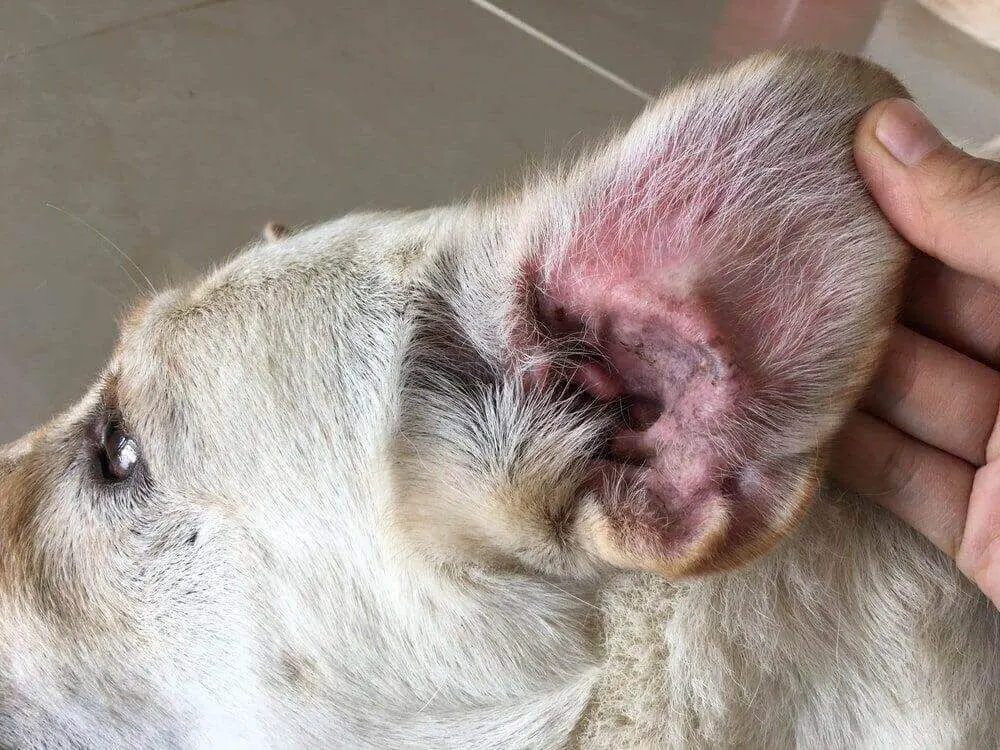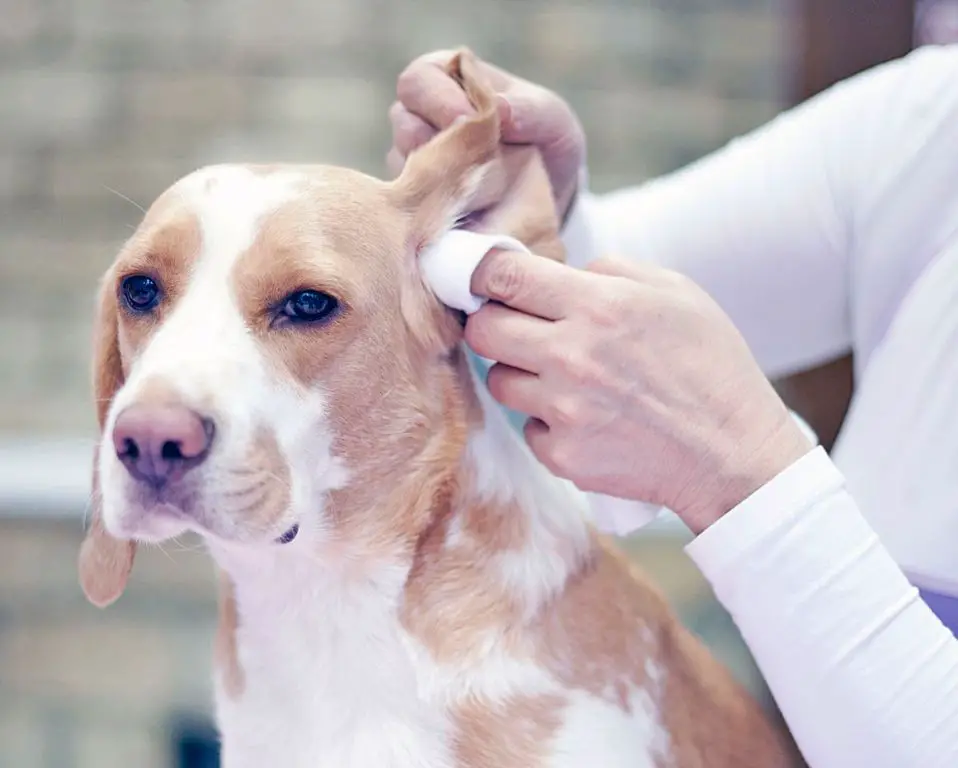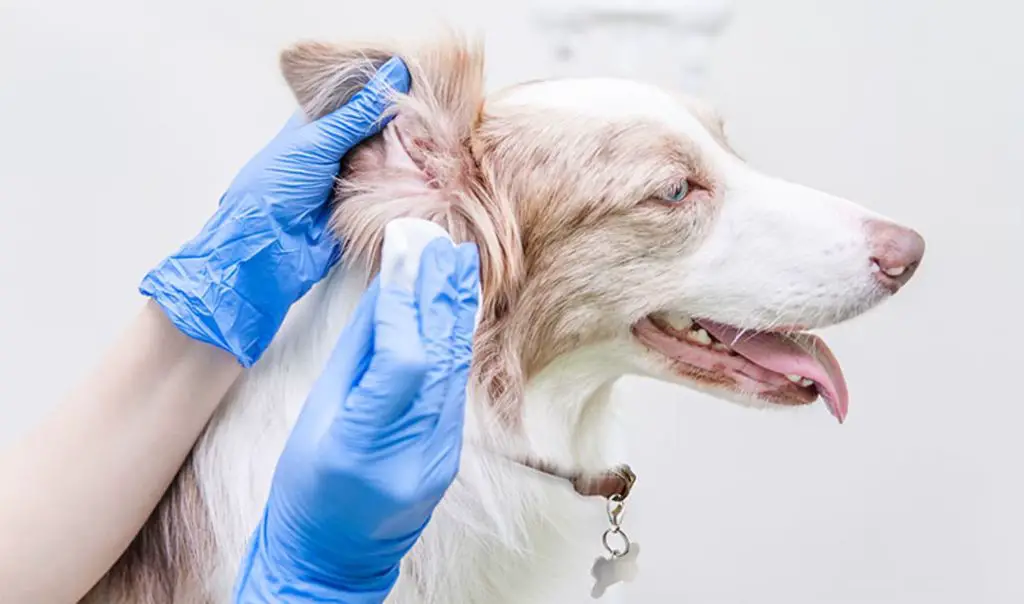Introduction
Just like humans, dogs also produce ear wax inside their ears called cerumen. Ear wax helps protect the ear canal by trapping dirt, dust, and bacteria. However, too much ear wax can cause discomfort and potential health issues for a dog.
While some ear wax is normal, an overproduction of wax may indicate an underlying issue such as an ear infection. Excess wax can also harden and block the ear canal, potentially leading to hearing loss and discomfort. Signs that your dog may need their ears cleaned include head shaking, scratching or rubbing at their ears, odor, discharge or redness.
While mild cases can be treated at home, severe buildup may require cleaning by a veterinarian. Regular cleaning helps prevent excessive buildup and reduces the risk of infection. With proper technique and precautions, dog owners can safely clean their dog’s ears at home in between veterinary visits.
Signs That Ear Cleaning Is Needed
There are some telltale signs that indicate your dog’s ears need cleaning. Be on the lookout for the following:
Head shaking or scratching – If your dog is shaking their head or scratching at their ears more than usual, this is a clear sign of irritation and discomfort in the ear canal. The head shaking is an attempt to dislodge debris or relieve itchiness. Scratching can cause trauma and infection.

Redness or swelling – Check inside your dog’s ears and look for any red, pink or swollen areas. Inflammation indicates an issue like an infection or hematoma. Swelling can also make the ear canal too narrow, trapping debris and moisture inside.
Bad odor – A foul, yeasty or piercing stench from your dog’s ears is abnormal. Unpleasant odors are typically a sign of infection from yeast, bacteria or ear mites. The infection causes an accumulation of wax and discharge which gives off the bad smell.
Risks of Left Untreated
Leaving excess ear wax and debris untreated can lead to some concerning health issues for your dog. Some of the most common risks include:
Ear Infections
Excess ear wax can trap moisture, dirt, and bacteria inside your dog’s ear canal. This damp, dirty environment promotes the growth of yeast and bacteria, which can cause painful ear infections.
Dogs with floppy ears like Cocker Spaniels and Basset Hounds are especially prone to infections. Left untreated, these infections can worsen and spread. This can lead to symptoms like head shaking, odor, redness, swelling, discharge and crusting of the ears.
Hearing Loss
Built up ear wax can plug your dog’s ears and muffle sounds. In severe cases, this wax blockage can cause partial or total deafness by preventing sound waves from reaching the eardrum.
Hearing loss typically starts out temporary, but may become permanent if the blockage remains for too long.
Ruptured Eardrum
In rare cases, a severe ear infection allowed to persist untreated can actually rupture your dog’s eardrum. This is an extremely painful condition that requires urgent vet attention.
A ruptured eardrum not only causes hearing loss, but leaves your dog vulnerable to additional infections.
When to See a Vet
There are some cases when you should speak to your veterinarian before attempting to clean your dog’s ears at home. Here are some signs it’s time to make an appointment with your vet:

- Severe buildup – If earwax and debris has severely built up in your dog’s ears, to the point where barely any of the ear canal is visible, a vet should examine your dog. Severe buildup can indicate an infection or other health issue.
- Frequent infections – If your dog gets ear infections often, even with regular cleaning, take them to the vet. Recurring infections likely mean an underlying issue needs to be addressed.
- Ear bleeding – Any bleeding from the ears could signal a serious health problem. Immediately take your dog to the vet if you notice blood when cleaning their ears or on bedding.
In these instances, it’s important your vet thoroughly examines your dog’s ears. They can determine if medication is needed, identify any root causes of problems, and provide guidance on safe and effective cleaning techniques.
How to Clean Ears at Home
Cleaning your dog’s ears at home can help prevent infections, but it’s important to use proper technique and solutions. Here are some guidelines for safely cleaning your dog’s ears at home:
Use a proper dog ear cleaning solution. Do not use cotton swabs or other products meant for human ears. A good dog ear cleaner will contain gentle cleansing and drying agents. Avoid harsh ingredients like alcohol which can dry out the delicate ear canal.
Apply the cleaner to a cotton ball, never directly into the ear canal. Gently wipe just inside the ear, massaging the base and only going as far into the canal as you can see. Never jam cotton swabs or other objects down the ear canal.
Wipe gently and stop if your dog shows signs of pain. The ear canals are highly sensitive. Excessive force can harm the eardrum or spread infection deeper. If your dog struggles, it’s best to take them to the vet for a more thorough cleaning.
Over-cleaning can also irritate your dog’s ears. Unless directed by your vet, limit cleanings to once a week or when buildup is visible.
Aftercare
After cleaning your dog’s ears at home, it’s important to monitor them for any signs of irritation or infection. Look out for redness, swelling, or discharge in or around the ears. Your dog may also shake their head more than usual.
Try to keep your dog’s ears dry for a few days after cleaning. Don’t allow them to swim or bathe until the ears look normal again. Moisture can irritate the sensitive skin inside the ear canal.
If you notice any abnormalities or your dog seems uncomfortable, contact your veterinarian. They can examine the ears and provide medication if an infection has developed.
Schedule a follow-up appointment with your vet within a week after cleaning your dog’s ears at home. Even if everything seems fine, it’s a good idea to have them double check that the ears are healthy.
Prevention
There are several steps you can take to prevent excessive ear wax build up in your dog:
Regular cleaning – Cleaning your dog’s ears regularly, such as once a week or every other week, can help prevent wax and debris from accumulating. Use a veterinarian-approved cleanser and cotton balls to gently wipe out excess wax.

Treat allergies – Allergies are a common cause of increased wax production. If your dog has allergies, treating the allergies with medications, allergy diet food, and minimizing exposure to allergens can reduce ear issues.
Dry ears after swimming – After your dog goes swimming, thoroughly dry their ears to remove any trapped moisture. Use a cotton ball or clean towel to gently wipe inside the ear canal.
When Not to Clean Ears
Though keeping your dog’s ears clean is generally recommended, there are some instances when you’ll want to avoid cleaning their ears altogether:
No signs of buildup
If your dog’s ears appear clean, with no dirt, debris or wax visible, then cleaning is unnecessary. Over-cleaning healthy ears can strip away protective oils and cause irritation.
Currently infected
If your dog has an ear infection, cleaning can make symptoms worse. Leave cleaning to your veterinarian, who can prescribe medication to treat the infection before attempting to flush the ears.
Damaged eardrum
If your dog has a ruptured eardrum from injury or infection, getting solution into the middle ear can cause significant pain and complications. Avoid cleaning unless directed by your vet.
Professional Cleaning
Sometimes a deep, thorough ear cleaning is best left to professionals. Many veterinary clinics and groomers offer ear cleaning services that can tackle more severe buildup that’s deep in the ear canal.
For dogs that are anxious, fussy, or sensitive about their ears being handled, sedation may be used so the cleaning can be performed safely and comfortably under anesthesia. This allows the vet or groomer to thoroughly clean the entire ear canal without any discomfort to the dog.

Regular professional ear cleanings may be recommended for dogs prone to excessive wax and debris. While home cleanings can maintain clean ears in between, a deep veterinary cleaning provides a more complete flush out. Some clinics offer regular ear cleaning packages as part of their routine wellness plans.
Owners should discuss with their vet when an appointment just for ear cleaning is advisable based on their dog’s needs. For severe buildup or infection, professional cleaning combined with medications may be necessary. Regular cleanings can also keep problems in check for dogs prone to waxy, dirty ears.
Conclusion
In summary, regular ear cleaning is an important part of dog ear care. Left untreated, earwax buildup and other debris can lead to painful infections. While occasional cleaning with a cotton ball may be sufficient for some dogs, others require more frequent attention.
Be sure to watch for signs of irritation and discharge, which indicate a vet visit is needed. For routine cleaning, gentle solutions and proper technique will remove dirt while protecting delicate ear tissue.
Afterwards, monitor your dog’s behavior to ensure proper healing. With diligent care, your dog’s ears will stay healthy and comfortable.
For more information, consult your veterinarian or visit reputable pet care sites. With the proper knowledge, ear cleaning can be simple and stress-free for both you and your dog.
By taking the time to regularly care for your dog’s ears, you help prevent problems down the road and strengthen your close companionship.